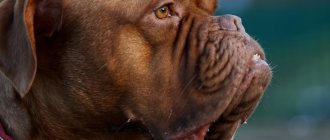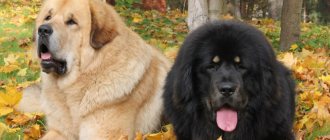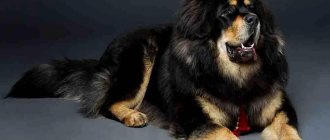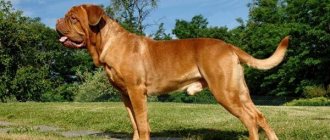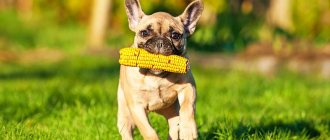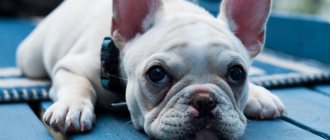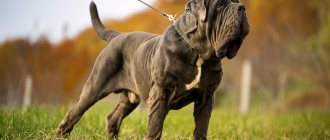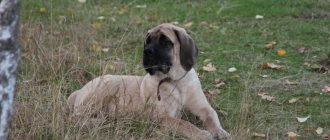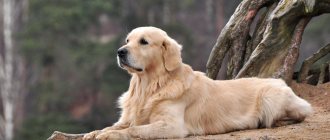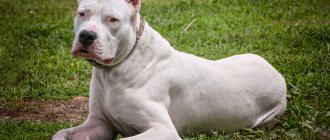Review author: “ZooVita”
The Dogue de Bordeaux is a dog breed also called the Bordeaux Mastiff and the French Mastiff. Possessing a formidable appearance and impressive size, this breed is a loyal friend and selfless protector for its owners.
Like any living creature, this dog will require some effort in care and feeding, but in return it will be ready to follow its owner along the path of life, both into the fire and into the fire.
Origin story
The founder of the breed is the Englishman James Hinks. Thanks to him, experimental fighting dog puppies with an elongated rat muzzle were born. The exterior of bull terriers was formed as a result of 10 years of crossing the extinct breed of white terrier and English bulldog, with admixtures of Dalmatian blood.
The main goal - to get a fearless dog with a high pain threshold - was achieved. The beauty and aesthetics of the animal’s external appearance were not considered.
At the end of the 19th century, the breed was recognized by the English Kennel Club. At the beginning of the 20th century it was allowed to reproduce. Keeping a bull terrier has become a prestigious occupation that emphasizes social status.
Training
Training the Dogue de Bordeaux will require the owner to be patient or seek help from a professional trainer.
Although Bordeaux dogs are highly intelligent, this adds additional complexity to the training process, since from childhood the dog must be taught to trust people, namely the owner. It is better to start training a Great Dane from three weeks of age.
The main rule for a puppy should be that the owner is the leader of the “pack” and obedience to him must be unquestioning.
Throughout its life, the Dogue de Bordeaux will try to find weaknesses in its owner in order to manipulate at their expense. Another negative feature of this breed that is worth paying attention to when raising is the dog’s excessive intrusiveness.
Encouragement should be chosen as a training tactic, since getting such a dog to do something is extremely problematic. Another important point is to walk your dog on a leash. A dog should not be allowed to pull its owner in the direction it wants.
Bull Terrier - description
Previously, this breed of dog was used for baiting wild animals and dog fighting. Since the ban on bloody spectacles, the breed has come a long way of socialization and managed to adapt to the requirements of modern people.
The Bull Terrier today is a loyal friend, a cheerful companion and an active athlete. Myths about its mortal danger have been dispelled. He is the embodiment of intelligence, endurance, strength and dexterity. His extraordinary appearance makes him look like a giant rat. The photo of a dog with a rat's face confirms this.
Bull Terrier - a dog with a rat face
Interesting Facts
Not every breed has a lot of interesting facts about itself , which cannot be said about the Shiba Inu.
There are simply a huge number of incredible, interesting and surprising facts associated with them; the most famous ones are presented in our list. Dogs can smile .
She is also called the “Smiling Dog”. In reality, they don't smile. Due to the special structure of the skull, a smiling grimace on a dog’s face occurs when the dog’s facial muscles are tense, when it blows through the sinuses. A dog named Ken-Ken is a well-known successful businessman in Japan on the island of Hokaido. Anyone can come up and buy delicious French fries or cookies from him, although the counter is self-service, but this does not prevent Ken from receiving good tips in the form of delicacies.
In the 2009 film “Hachiko, My Best Friend,” the Shiba Inu played the puppy Hachiko , while the adult dog was an Akita Inu.
Breed standard
The Bull Terrier has an international breed standard, deviations from which are considered a fault:
- The body is athletic, muscular, strong.
- The head is oval, ovoid in shape.
- The muzzle is elongated, arched.
- The neck is strong.
- The jaws are powerful, the compression force is 25 atmospheres.
- The mouth is big.
- The bite of the teeth is cross-shaped.
- The ears are erect, V-shaped, close set.
- The nose is pronounced and large.
- The eyes are small, triangular in appearance, slanted, wide and deep set.
- The tail is short and not docked.
- Average weight 30 kg, not limited by standard.
- Height at withers is from 40 to 55 cm. Males are larger than females.
- Life expectancy is 12-14 years.
Choosing a puppy
Before purchasing a Schipperke, it is advisable to look for reviews about the nursery where the breed is sold, and find out in what conditions the babies are kept. When choosing a puppy you need:
- Find out the pedigree of the male and female whose offspring are offered to buyers.
- Request and study documents for litter producers.
- Take a close look at what the babies look like.
You cannot order a Schipperke from a photo, since in the picture it is impossible to see the defects of the breed or understand the peculiarities of the animal’s behavior. The tail of a Belgian Shepherd puppy should not curl or be thickened. The brown coat color of babies turns black with age.
Character and education
The nature of the “boules” is specific. They have an extraordinary mind and can read a person’s thoughts. From the first days, it is necessary to extinguish the foci of their aggression and direct the strength and energy of the dogs in the right direction. With proper upbringing of a puppy and its early socialization, a good friend and protector will grow up.
Bull Terriers are hyperactive and require long-term physical and mental training. They are willful and stubborn. They are not characterized by cowardice and betrayal. Ready to protect the owner at the cost of life. Affectionate in the family, loyal to children and powerful in the world around them. Any representatives of the fauna are treated as prey. Walking without a leash is prohibited.
Hairless dogs
African hairless dog
The African Hairless Dog is one of the oldest dog breeds, originally from Mexico, where they were recognized as a national treasure. You can use your pet to protect your home or as a companion. The main feature of the pet is the absence of hair and delicate skin. Because of this, the dog has a hard time withstanding cold and rain. The hairless dog is distinguished by intelligence, independence and loyalty.
It is important that the breed first appeared more than 3 thousand years ago, as evidenced by mummies and ancient burials in Mexico.
Hairless American Terrier
The American Terrier was bred in America; the pets' ancestors were hunters. But due to the lack of hair, the American Terrier is demanding in climate and is used as an ornamental pet. By temperament - active, passionate, savvy animals, they love to learn new things and follow commands. The animal has no fur, but there may be brown or beige spots on its body.
Chinese Crested Dog
The Chinese Crested is a dog breed originally from Korea, characterized by activity, liveliness, loyalty and sociability. There are suggestions that the breed originated in Africa or Mexico. The peculiarity of the pet is the complete absence of hair, with the exception of the head and tail. The dog's skin color is pink, gray, beige with markings. This breed does not cause allergies and gets along well with other animals.
Manchurian Hairless Dog
The Manchurian Hairless Dog is most often found in the Manchurian region, in the mountains. Local residents call the pet “tai-tai”, but the breed is still not officially recognized by the dog handlers association. The dog also has no hair at all, it has much in common with the Chinese Crested, it does not smell and does not cause allergies. A hairless dog is characterized by loyalty, playfulness and affection for its owner.
Peruvian hairless dog
The Peruvian dog has a medium build, strong paws, and first appeared in Peru many centuries ago. The pet has no fur and is gray and spotted. Also, the Peruvian dog has almost no teeth, but by character they are kind, brave, intelligent animals. They love children very much and can be guards.
By the way, from the Inca language, the name of the Peruvian dog is translated as “Inca orchid”, since the pet is distinguished by grace and stubbornness.
Pharaoh Hound
The Pharaoh Hound belongs to the group of primitive, greyhounds. The breed appeared in Malta, although the first images of pets were found in drawings of Ancient Egypt, in which they personified Anubis. The dog has a small body, slender and muscular legs. The coat is almost absent or very short, the color is red or brown. The Pharaoh Hound is easy to train, loves outdoor games, adores its family and is ready to protect it under any conditions.
Ecuadorian hairless dog
The Ecuadorian dog is considered one of the rarest, it has the least fur compared to other hairless pets. Now you can meet a dog only in some regions of Africa, so there is no exact information about the nature and characteristics of care. They only note that the Ecuadorian Hairless dog is active and energetic, with an average body size.
Care and maintenance
In terms of grooming, the Bull Terrier is not difficult, he is clean:
- Brush the coat with a rubber mitten 2-3 times a week, daily during the shedding period.
- Clean your ears once a week.
- Wash your eyes daily.
- After walking, wipe with a damp towel.
- Bath with shampoo as needed.
- Trim the claws.
Keeping exclusively at home, preferably in a family without children. Aviary and chain housing breaks the animal’s psyche and leads to its aggression. The bull is afraid of the cold; at temperatures below -10, walk in clothes. During the hot season, refrain from exposing your pet to the sun.
Nutrition
There are several options for how to properly feed the Dogue de Bordeaux so that the dog has good health and proper metabolism. One of the options is a completely natural diet that does not include special ready-made food.
With the second type of feeding, the dog’s “menu” can be supplemented with commercial food. Bordosses need a varied diet, based on a meat diet, but also including plant foods.
It is also advisable to feed the Great Dane with dairy products and sea fish. If it is not possible to add vegetables and fruits to the dog’s diet, they must be replaced with supplements containing vitamins and minerals.
When feeding your dog with ready-made industrial food, you should give preference only to truly proven, trusted manufacturers. Ideally, it is better to consult a veterinarian about the type of finished food that is selected for your Great Dane.
It should be remembered that there are a number of foods that you should not feed your dog: river fish, any foods with caffeine, spicy and salty foods, mushrooms, raw meat and eggs, legumes, excessively fatty foods, sugar-containing foods, citrus fruits and onions.
Pros and cons of the breed
Like all dogs, the English Bull Terrier has its own advantages and disadvantages.
| pros | Minuses |
| Has intelligence | Difficult to train |
| Suitable for apartment living | Does not tolerate frost and heat well |
| Shedding is not pronounced | Presence of genetic diseases |
| Easy to care for | Suitable for experienced dog owners only |
| Playful and active | Difficult to educate, complex character |
| Acts as a companion | Prone to aggression |
| Has security and protective qualities | Doesn't get along with other pets |
| Strong and dexterous | Jealous, capricious, vindictive |
| Fearless | Free range is prohibited |
At what age is the fifth toe amputated in dogs?
It is recommended to resort to surgical intervention as early as possible. Ideally, it should be combined with cupping, if it is necessary according to the standard. At a young age, anesthesia is easier to tolerate and wounds heal much faster.
In puppies
It is recommended to remove dewclaws from puppies 3-6 days after birth. Starting from 1 week of life and up to 16, surgery is temporarily prohibited.
Most often, they resort to it only after reaching a year. This is due to the fact that in the first days, local anesthesia is enough for puppies, and on the 7th day they have to resort to general anesthesia. For this reason, the baby must grow up and get stronger in order to avoid unpleasant consequences associated with anesthesia.
In adult animals
After a year, amputation becomes more difficult, which affects its cost and rehabilitation period. And while puppies are often operated on right at home, adult animals are operated strictly in a veterinary clinic.
Irish Wolfhound
This is one of the tallest dog breeds. As the name suggests, it comes from Ireland. Irish Wolfhounds were originally bred to hunt large animals (deer, wolves) and protect territory.
The Irish Wolfhound is one of the oldest dogs living with people. They are known for their incredible speed and size; some individuals reach 90 cm in height and weigh up to 80 kg. Their large stature and athletic build make them look intimidating, but with training, the Irish Wolfhound can make an excellent pet with unwavering loyalty to its owners.
With proper training, Irish Wolfhounds can also be taught to get along with children and be gentle with them. Being intelligent dogs, wolfhounds are highly trainable. They have an essentially calm and good-natured disposition, but can become quite aggressive if provoked.
English bulldog
Bulldogs are one of the most recognizable breeds with their stocky build, striking bite, supple lips and wrinkled muzzles. Short-legged, but muscular and strong, English bulldogs were originally bred for baiting animals. So don't be put off by their small size, as they have no shortage of power and endurance.
The Bulldog comes from the UK, where they are considered a kind of mascot. Many compared British Prime Minister Winston Churchill to a bulldog due to his unwavering tenacity and rugged charm. Their cheeky appearance attracts many dog lovers, it is no wonder that English Bulldogs are among the ten most popular dogs in Europe.
Although English Bulldogs retain the energy and strength they were bred to have, they gradually learned to control their aggression. Modern bulldogs can be trained to remain calm. This, combined with the fact that Bulldogs often develop a strong bond with children, makes them an excellent choice for families.
Cane Corso
This is a giant dog breed whose ancestry dates back to ancient Roman times. She is famous for her vigilance and devotion to her owners. And the fact that the Cane Corso weighs more than 45 kg and has a fairly muscular body makes this breed a scary breed for any potential attackers.
However, they are not an ideal choice for first-time dog owners because adapting these dogs to your lifestyle requires a lot of consistent and dedicated training.
For experienced dog owners, Cane Corsos can make excellent watchdogs and loyal companions. They can be trained to be obedient pets. Unlike many strong dog breeds, the Cane Corso does not have high demands on physical activity.
Belgian Malinois
The Malinois is a type of Belgian Shepherd. This is a graceful, powerful working dog bred primarily for herding. She is smart, quick-witted, active and has a strong character.
The Belgian Malinois is an excellent dog for detecting prohibited items and protecting people and property, which is why it is often used as a police dog. They also make excellent watchdogs, but they require a lot of exercise. So, only get a Belgian Malinois if you can take him for walks every day and provide him with plenty of opportunities to play.
Rottweiler
For centuries, since the times of the Ancient Roman Empire, Rottweilers have been used as working dogs, especially for herding and guarding livestock. They make excellent guards. Although they still perform their traditional herding job in some parts of the world, Rottweilers have become more commonly used by police and military personnel as guard dogs or kept as pets.
However, when kept as pets, Rottweilers require proper training. Since they naturally like to dominate, they need to be taught to follow orders from an early age. Otherwise, they will take on the role of leader and begin to boss you around, which you definitely don’t want.
Rottweilers tend to be fiercely protective of their owners and can act aggressively around strangers if they are not socialized. They respond best to confident and experienced dog owners, so beginners should not get them. In addition, Rottweilers have high physical demands. They need vigorous exercise every day. This makes them an unsuitable option for very busy people.
